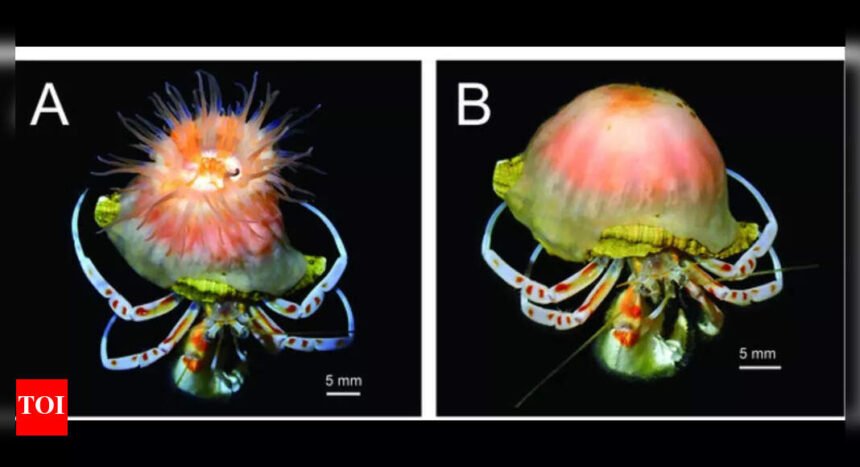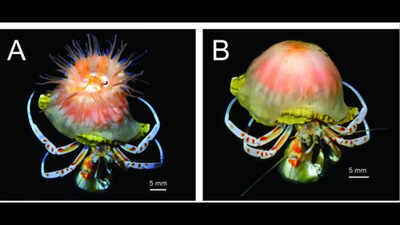Beneath the waves off Japan’s Pacific coast, scientists have made a discovery that seems straight out of a nature documentary: a pale pink sea anemone that actually builds homes for hermit crabs. Named Paracalliactis tsukisome, this elegant creature isn’t just another deep-sea oddity; it’s a living architect of the ocean floor. Found hundreds of metres below the surface, it forms an extraordinary partnership with hermit crabs, crafting shell-like structures that grow with their hosts. This surprising alliance challenges what we thought we knew about marine life, showing that even the simplest organisms can display astonishingly complex and purposeful behaviour in the dark depths of the sea.
This newly found Sea Anemone builds permanent homes for hermit crabs
The relationship between Paracalliactis tsukisome and its hermit crab companion is an example of mutualism, where both species benefit from each other. The sea anemone secretes a carcinoecium, a hard, shell-like covering that reinforces and expands the crab’s housing. This unique structure grows as the crab grows, eliminating the need for the crustacean to constantly find new snail shells.In return, the anemone gains stability and mobility on the dark, food-limited seafloor. This relationship demonstrates an intricate balance of cooperation and shared benefit, a hallmark of ecological efficiency in extreme habitats.
Two-way benefit: Sea Anemone feeds on crab waste while offering extra protection
Stable isotope analysis, which tracks how different atoms move through food webs, revealed that the anemones and crabs share similar diets. The anemones had slightly higher nitrogen levels, suggesting they feed on a mix of crab waste and drifting particles. This supports a two-way exchange of resources rather than a parasitic relationship.Interestingly, hermit crabs living with Paracalliactis tsukisome grew larger than related species without such anemone partners. A stronger, custom-built shell likely provides extra protection, reducing the need for frequent shell swaps, an energy-intensive and risky task in deep waters.
Engineering precision in the deep sea
Unlike most sea anemones that attach randomly, Paracalliactis tsukisome grows its hard extension with directional accuracy. It secretes smooth material around the shell’s opening, keeping the entrance clear for the hermit crab. This controlled growth shows a surprising level of structural awareness in an organism without a central nervous system.The anemone’s precision suggests it can sense orientation and position, an ability previously thought to be limited to more complex animals. Future laboratory studies may explore how water flow and food availability influence its shell-building behaviour.
How a deep-sea partnership sheds light on the evolution of mutualism
The study, published in the journal Royal Society Open Science, not only introduces a new species but also highlights the intricate biological and behavioural adaptations that support survival in extreme environments.By combining micro-CT imaging, isotope analysis, and genetic sequencing, the researchers built a complete picture of how Paracalliactis tsukisome and its crab partner cooperate. The findings also offer insights into how mutualistic relationships evolve, and how marine life innovates under pressure.As deep-sea exploration continues, discoveries like this remind us how much remains unknown beneath the ocean’s surface. The delicate bond between Paracalliactis tsukisome and its hermit crab companion is not just a testament to survival but also a story of remarkable biological ingenuity.






